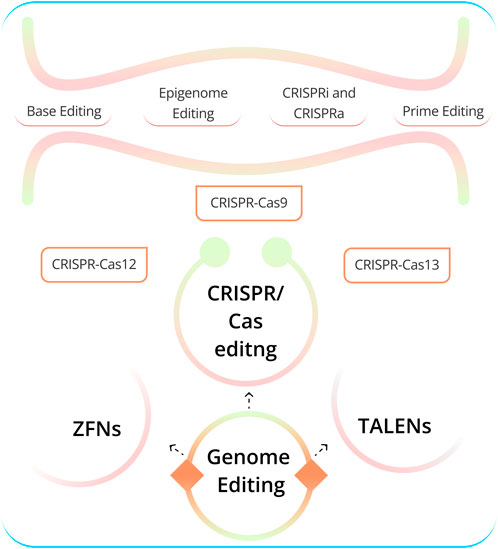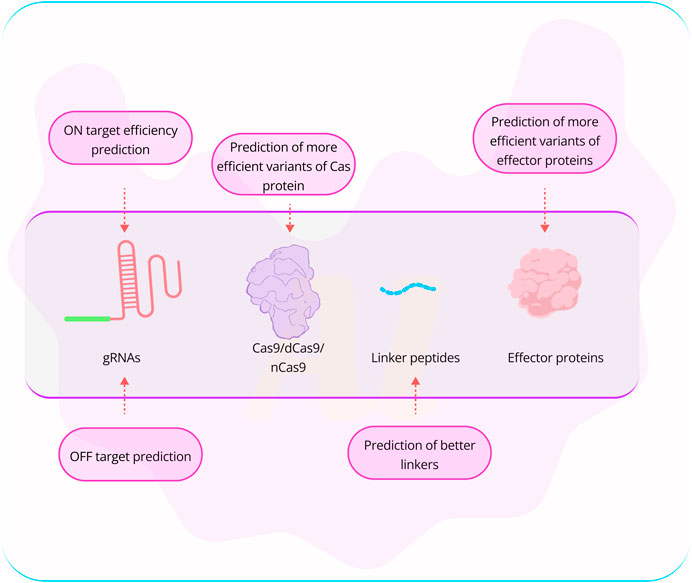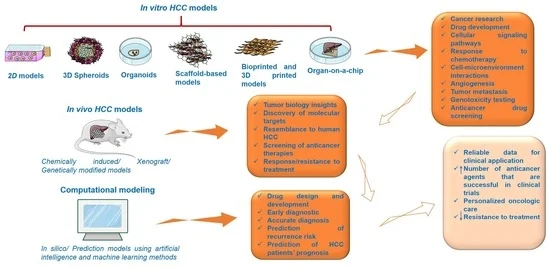Artificial intelligence (AI) helps genome editing achieve more efficiency, precision, and affordability in tackling various diseases, like Thalassemia or Sickle cell anemia . AI models have been in use for designing guide RNAs (gRNAs) for CRISPR-Cas systems. AI, in collaboration with genome editing and precision medicine, enables personalized treatments based on genetic profiles. AI analyzes patients’ genomic data to identify mutations, variations, and biomarkers associated with different diseases like Cancer, Diabetes, Alzheimer’s, etc. The integration of AI and genome editing opens up new possibilities for genetics, biomedicine, and healthcare, with significant implications for human health.

FIGURE 1. Various aspects of Genome editing. CRISPR encompasses various gene-editing approaches.
In the decade since the publication of CRISPR-Cas9 as a genome-editing technology, the CRISPR toolbox and its applications have profoundly changed basic and applied biological research.The advent of clustered regularly interspaced short palindromic repeat (CRISPR) genome editing, coupled with advances in computing and imaging capabilities, has initiated a new era in which we can not only diagnose human diseases and even predict individual susceptibility based on personal genetics but also act on that information.

FIGURE 2. CRISPR: past, present, and future.

Fig. 3. CRISPR-based adaptive immunity provides programmable genome editing tools.

Fig. 4. Challenges associated with genome editing using CRISPR technology.
One of the most acknowledged challenges in CRISPR-based genome editing is the efficiency of on-target editing and the potential off-target effects. CRISPR-based editing technologies like CRISPR/Cas9 allow for precise and targeted editing of the genetic code of organisms, which is a major breakthrough in biotechnology.However, AI’s integration with CRISPR, improves the overall GED pipeline, providing new insights, capabilities, and opportunities for manipulating and understanding the genetic code.
The first step in developing AI models for gene editing involves the collection of extensive genetic data. Choosing the right type of model is essential for the success of AI applications in gene editing. Training the AI model involves exposing it to a labeled dataset where it can learn the patterns and relationships within the genetic information. Once the model is trained, optimization is performed to enhance its performance. This involves fine-tuning parameters, adjusting architectures, and employing optimization algorithms to maximize the accuracy and efficiency of the gene editing predictions. The finalized AI models are integrated into healthcare systems to assist clinicians in making informed decisions regarding gene editing.

Fig. 5. AI driven gene therapy process.
Genome editing technologies, particularly CRISPR-Cas9, have opened exciting possibilities for understanding genes and improving medical treatments. The integration of AI plays a vital role in enhancing the precision, efficiency, and affordability of genome editing. AI models have been employed in designing gRNAs for CRISPR-Cas systems, widely used in genome editing. technologies.
AI, in conjunction with Genome Editing and precision medicine, enables personalized treatments based on genetic profiles. It analyzes patients’ genomic data, identifying disease-associated mutations, variations, and biomarkers, such as those in cancer, diabetes, Alzheimer’s, and more. As technology continues to evolve, the synergy between AI and GED will continue to shape the field of genetics, biomedicine, and healthcare, with far-reaching implications for the betterment of human health.


